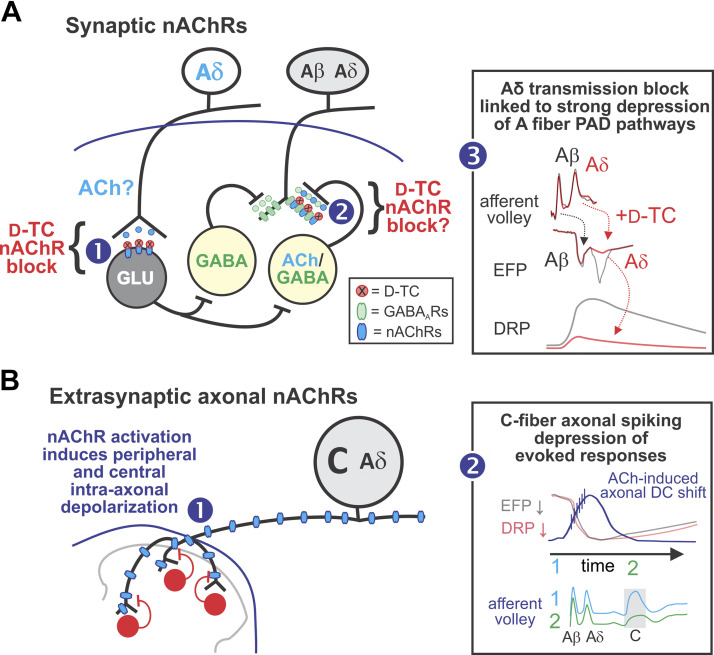Figure 10.
Summary of primary results and putative mechanisms responsible for synaptic (A) and extrasynaptic (B) nicotinic acetylcholine receptors (nAChR)-mediated actions on afferent signaling. A: nAChR antagonist depression on Aδ afferent synaptic transmission and dorsal root potentials (DRPs). Selective depression of monosynaptic Aδ extracellular field potential (EFPs) with nAChR antagonist d-TC supporting direct actions at this synapse including afferent release of ACh or related agonist acting on postsynaptic nAChRs. As selective depression of Aδ afferents monosynaptic actions is associated with a large reduction in the DRP, these first-order interneurons may act directly on the interneurons mediating primary afferent depolarization (PAD) [1]. Nicotinic AChR antagonists may also reduce PAD via actions on last-order axo-axonic synapses originating from lamina III cholinergic/GABAergic interneurons, but this contribution would be small owing to the well-established prominent contribution of GABAARs in A-fiber-evoked PAD [2]. Summary of observed actions relating selective d-TC block of Aδ afferent transmission to a strong depression of A-fiber-evoked DRP (PAD pathways). B: extrasynaptic axonal nAChR-mediated actions on afferent signaling. Pharmacological extrasynaptic activation of nAChRs generates axonal depolarizing DC shifts both peripherally and intraspinally [1] . Summary of proposed interacting events linking direct current (DC) shifts to loss of evoked responses [2]. The rising phase of the depolarizing DC shift is associated with spontaneous activity in peripheral axons. A prior study demonstrating nAChR-mediated excitability increases in unmyelinated C-fibers (21) is consistent this observation. Subsequent loss of spiking during increasing axonal depolarization is consistent with depolarization block causing conduction block. Conduction block is seen preferentially in slower-conducting axons (Aδ- and C-fibers), particularly in high-threshold C-fibers. nAChR-mediated axonal depolarization coincides with strong depression of Aβ and Aδ EFPs and DRPs. Although the loss of evoked responses corresponds to the rising depolarizing DC shift and observed axonal spiking, depression of evoked responses is long-lasting and does not recover with DC repolarization. d-TC, d-tubocurarine.

